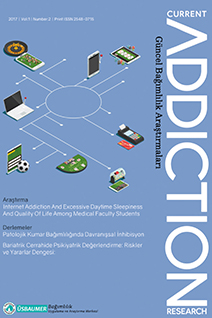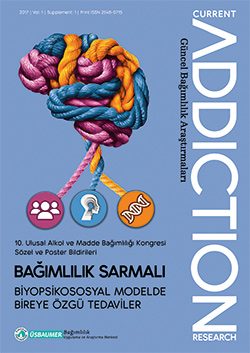ARTICLES
Editorial
Nesrin Dilbaz
2017, 1(1), s:9-11
Editorial
Çelik Hüseyin
2017, 1(1), s:13-15
Original Article
Zeynep Ülke,Cemal Onur Noyan,Nesrin Dilbaz
2017, 1(1), s:16-25
Objective: The objective of this study was to adapt the “Bergen Facebook Addiction Scale (BFAS)” developed by Adreassen et al (1) into Turkish, and to evaluate the reliability and validity of the Turkish version of the Bergen Facebook Addiction among university students.
Method: The study was conducted in 2015 at Uskudar University and Yeditepe University (Istanbul-Turkey) with a total of 300 students from different majors and age groups. The draft scale was finalized after being translated and corrected by experts in the relevant fields. To determine the validity of the scale; factor analysis was performed and the results revealed that, of the 6 items reflecting the six core elements. It was detected that all items were distinctive with respect to relationship of each item with its related factor. Reliability level was determined by test – retest and internal consistency analysis. In addition, to test the criterion dependence validity of the scale, the correlation between the data gathered from Bergen Facebook Addiction Scale was analyzed respectively with data collected from the Smartphone Addiction Scale, Facebook Use Variance and Facebook Addiction Self-evaluation.
Results: The internal consistency coefficient was calculated using the Cronbach’s Alpha formula and gave a result of crα= .89. The 3-week test-retest validity Cronbach’s alpha was .76 for the six-item Bergen Facebook Addiction Scale. The factor analysis and testretest results confirmed the reliability and validity of the 6-item scale.
Conclusion: Bergen Facebook Addiction Scale is able to measure reliably, and the scale is a valid and reliable tool to be employed in a clinical environment to predict addiction levels of individuals regarding Facebook use in the Turkish society as well.
Original Article
Treatment And Approaches On Acute Agitation Among in Patients in a Private Psychıatry Hospital
Aslı Enez Darçın,Cemal Onur Noyan,Serdar Nurmedov,Hasan Kaya,Nesrin Dilbaz
2017, 1(1), s:26-32
Aim: It is aimed to determine the association between the indications of acute agitation call, applied treatment, applied restraint and seclusion with the
sociodemographical and clinical characteristics of psychopathology.
Method: Among inpatients in a private psychiatry hospital, medical records of whom has a form filled for acute agitation between June 2013-April 2014 examined
retrospectively, 137 medical records enrolled. Acute intervation form and brief psychiatric rating scale points that had been filled in the same day were determined.
Results: In the duration of the study acute agitation call applied for 16.4% of inpatients, 1.9% were restrained, 8% were secluded and 9.4% were given acute medication.
While the applied physical restraint and seclusion rates did not differ during the day, drug applications were found in higher rates during daytime hours (p<0.05). According to the hours of application, the duration of physical restraints were constant throughout the day while the duration of seclusions were longer in the night hours (p<0.05). The most common causes of acute agitation were aggression, threat of violence and treatment rejection. There was no difference approaches to acute agitation in terms of the diagnosis. The majority of selected drug treatments for acute agitation were intramuscular injections. No association was found between scale scores and the duration of any application.
Conclusion: Lower rates of restraints in our study could be associated with that the sample of this study was chosen from a private psychiatry hospital. There is need
for further training among treatment team and studies in this area to shed light on the development of approaches.
Review Article
Genetics Of Alcohol Use Disorder
Hasan Kaya,Özlem Bolat Kaya,Nesrin Dilbaz
2017, 1(1), s:33-46
Introduction: Alcohol Use Disorder (AUD) is a chronic
psychiatric disorder characterizes by harmful drinking
patterns leading to negative emotional, physical, and
social outcomes. Twin, family, and adoption studies
have consistently demonstrated that genetic factors
play a critical role in the pathogenesis of AUD. Various
studies have aimed to identify genes that contribute
to susceptibility to AUD. In this paper, we provide
an review of genetic studies on AUD, including twin
studies, linkage studies, candidate gene studies, and
genome-wide association studies (GWAS). Growing
evidence indicates that AUD is a complex genetic
disease, with variations in a substantial number of gene
affecting a person’s risk of AUD. Some of these genes
have been identified, including two genes involved in the
metabolism of ethanol (ADH1B and ALDH2) that have
the strongest known affects on the risk of AUD. Studies
continue to find out other genes in which variants affect
the risk of AUD or related traits, including GABRA2,
DRD2, OPRM1, MAOA and PECR. As more variants
are analysed and studies are integrated for meta-analysis
to obtain increased sample sizes, an enhanced picture of
the many genes and pathways that affect the risk of AUD
will be possible.



 2. Sayı
2. Sayı
 1. Sayı
1. Sayı
 Ek Sayı
Ek Sayı







